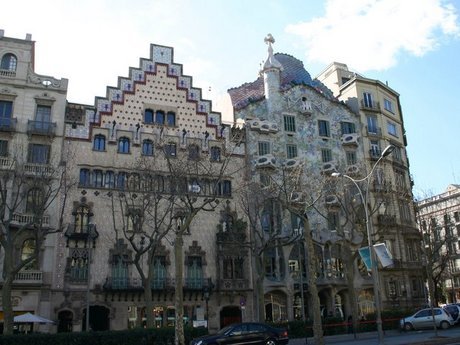Casa Amatller
This is one of three houses in this fashionable block designed by a prominent Modernista architect, the other two being Casa Morera by Domènech i Montaner and Casa Batlló by Gaudí. But each of the houses is in a very different style, giving rise to the punning term Mançana de la Discòrdia, meaning "apple of discord" (mançana is the Catalan word for both "apple" and "block"). These three houses were all essentially remodelling jobs with alterations to existing buildings. Here Puig i Cadafalch designed the facade, a foyer, and the owner's residence in the "new" Modernista style.
The sculptor Eusebi Arnau created the St. George with the dragon which decorates the doors on the left side of the asymmetrical facade. (St. George or Sant Jordi is the patron saint of Catalonia.) The facade has decorative sculpture and stonework, beautiful wrought iron ornament, tiles, and subtle sgraffiti. Stylistic borrowings are eclectic with the stone work resembling Gothic carving and the facade roof line straight from 17th century Holland.
Constructed in a cubical design with a Dutch gable, this building was created by Puig i Cadafalch in 1900 and was the first building on the Manzana de la Discordia. It stands in sharp contrast to its neighbor, the Gaudí-designed Casa Batlló . The architecture of the Casa Amatller, imposed on an older structure, is a vision of ceramic, wrought iron, and sculptures. The structure combines grace notes of Flemish Gothic - especially on the finish of the facade - with elements of Catalan architecture. The gable outside is in the Flemish style. Look out for the sculptures of animals blowing glass and taking photos, both hobbies of the architect. They were executed by Eusebi Arnau, an artist much in demand by the modernistas.
Guided visits to the main floor, former residence of the industrialist Antoni Amatller, to appreciate the current state of the unique Modernista interior complete with its original furniture and interior design. After the restoration, the Casa Amatller will become a cultural venue of outstanding note for explaining Modernismo. The visits are dependent on the course of the restoration and refurbishment work on the Casa Amatller.
Casa Amatller is one of the celebrated cornerstones of a block of Passeig de Gràcia known as la manzana de la discordia - 'the block of discordance', referring to the many unconventional architectural styles on show in buildings by Barcelona's triumvirate of world-famous modernist architects, GaudÏ, Puig i Cadafalch and Domènech i Montaner.
Montaner's building is often described as pseudo-Flemish, on account of its drawing upon Catalan and Flemish styles, fusing them into a unique vision. Highlights include sculptures by Eusebi Arnau of handless drummers with dancing bears, St George and even the original landlord, Antonio Amatller's daughter as a princess.
Some of the animals depicted appear to have chocolate melting out of them, a reference to the chcocolate magnate Antonio Amatller who was Montaner's patron.
The house combines touches of Roman, gothic and baroque styles using the classic materials of the time. Wrought iron takes on whimsical forms, glasswork decorates many corners and mosaics cover most of the walls. The bottom floor, home to one of the most prestigious Catalonian jewellery houses, has conserved the original windows so that their floral ornamentation can still be admired.
Josep Puig i Cadafalch designed a number of other buildings in Barcelona, such as the Casa de les Punxes and the Casa Terrades. The Casa Amatller was constructed at the beginning of the 20th century and its six cupolas give it a medieval feeling. Due to the political circumstances during the time in which Puig i Cadafalch was professionally active, he had to go into exile to Paris in 1936. That was the year the Spanish Civil War broke out. When it came to an end in 1939, the ruling dictator's government did not allow him to return to Spain to practice his profession.
Much like the Casa Lleó-Morera, the Casa Amatller is privately owned, but its interior can be visited on specific days of the week. Tours are given in Spanish and Catalan every Wednesday at 12pm and in English every Friday at 12pm. The main entrance is always open, and the bottom floor is often used for temporary exhibitions. Visitors can also tour the interesting chocolate shop that offers a look into the history behind the building's construction. Chocolate industrialist Antoni Amatller bought the building in 1898 and commissioned Josep Puig i Cadafalch to remodel it.
Casa Amatller offers incredible sights right in the middle of Barcelona. Don't miss to visit it after your flight to Barcelona. There are lots of hotels in the area, so you can start your travel in Barcelona from there.
Sadly you can't go inside as yet, but there is a gift shop and the first floor, which was once chocolate magnate Antonio Amatller's home (1851-1910), is being restored to its former glory, thanks to a project by the local council. The project is to recreate the original apartment, detail for detail, and will be open to the public in future. Passeig de Gràcia metro station is a very short walk and is served by the green, yellow and purple lines. You can get there via direct flight to Barcelona or to Girona, Reus or Lleida –Alguaire.




